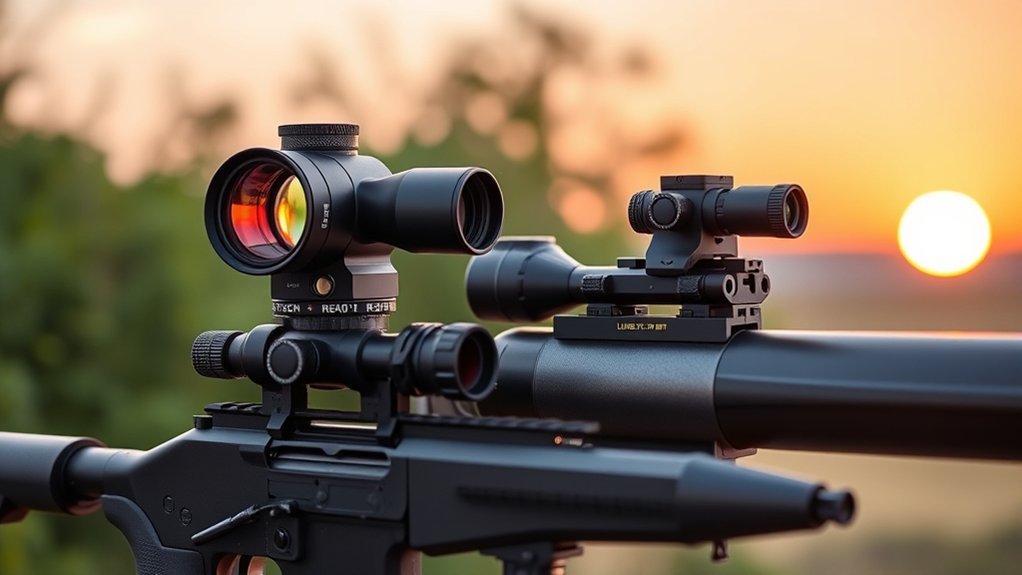Co-witnessing sights can dramatically enhance your shooting accuracy, yet improper alignment can lead to frustrating errors. Understanding the mechanics behind this technique is essential for any shooter looking to improve their performance. By exploring the various types of co-witnessing and how to set them up correctly, you’ll discover the nuances that can make or break your aim. What common pitfalls should you be aware of to guarantee your setup is optimized?
What Is Co-Witnessing?

Co-witnessing refers to the alignment of iron sights and optical sights on a firearm, allowing for simultaneous use of both sighting systems. This technique guarantees that both sights are calibrated to the same point of aim, facilitating quick shifts between sighting methods. You achieve co-witnessing by adjusting the height and positioning of your optical sight so that it aligns with your iron sights when viewed through the optic. There are two types of co-witnessing: absolute and lower third. Absolute co-witness places the optical sight directly in line with the iron sights, while lower third co-witness positions the optic slightly above the iron sights. By understanding these configurations, you enhance your shooting flexibility and efficiency in various scenarios.
The Importance of Co-Witnessing for Accuracy

When aiming for precision in shooting, ensuring that your sighting systems work harmoniously is essential. Co-witnessing provides a reliable reference point, allowing you to quickly shift between your primary optic and backup sights. This redundancy enhances your accuracy, especially in dynamic situations where speed is critical. By aligning your sights, you minimize the risk of misalignment, which can lead to significant errors. When your primary optic fails or is obscured, having co-witnessed sights enables you to maintain target acquisition without losing time. Furthermore, it instills confidence in your setup, promoting consistent performance under pressure. Ultimately, co-witnessing is an essential component in creating a robust shooting system, enhancing both precision and reliability in any shooting scenario.
Types of Co-Witnessing: Absolute vs. Lower 1/3

Having a solid understanding of the different types of co-witnessing can considerably impact your shooting setup. The two main types are Absolute Co-Witness and Lower 1/3 Co-Witness.
| Type | Description |
|---|---|
| Absolute Co-Witness | Your red dot sight aligns perfectly with the iron sights, allowing you to see both at the same time. |
| Lower 1/3 Co-Witness | The red dot appears in the lower third of your view, letting you utilize your iron sights without obstruction. |
Each option has its strengths; Absolute gives you a full view, while Lower 1/3 offers a clearer line of sight. Your choice will depend on personal preference and intended use, influencing your overall effectiveness in shooting scenarios.
How to Set Up Co-Witnessing Sights
To achieve an effective co-witness setup, you’ll need to carefully align your red dot sight with your iron sights. Start by mounting the red dot sight on your rifle, making sure it’s securely fastened. Next, use a laser bore sight or a target at a known distance to align the red dot with your iron sights; this guarantees both sights point to the same target. Once aligned, fire a few rounds to confirm accuracy. Adjust the elevation and windage settings on your red dot sight as necessary, keeping an eye on the relationship between the two sighting systems. After adjustments, double-check zero at various distances to ensure consistent performance. This thorough setup assures reliable sighting in various shooting scenarios.
Common Mistakes to Avoid
When setting up co-witnessing sights, you can’t afford to misalign your optics, as this can severely impact accuracy. Additionally, ignoring eye relief will lead to discomfort and hinder your shooting performance. Finally, neglecting reticle compatibility may result in a mismatch that compromises your overall sighting system.
Misaligning Optics Properly
While misaligning optics can lead to significant issues in sight accuracy, understanding common mistakes enhances your ability to achieve proper alignment. One frequent error is failing to verify the mounting base’s level; an uneven base can skew your point of aim. Additionally, neglecting to check the reticle’s alignment with the bore can result in drastic changes in your shooting accuracy. You might also overlook the importance of tightening screws uniformly, which can lead to optic shift during recoil. Finally, not utilizing a bore sight before live firing can cause frustration, wasting valuable time and resources. Avoiding these pitfalls will guarantee a more reliable and precise shooting experience, enhancing your overall effectiveness in the field.
Ignoring Eye Relief
Misaligning optics isn’t the only factor that can compromise your shooting accuracy; ignoring eye relief is another common mistake that can lead to serious consequences. Eye relief, the distance between your eye and the scope’s ocular lens, is essential for both comfort and safety. If you position your eye too close, you risk experiencing scope bite, while being too far can cause a loss of sight picture. Understanding the specific eye relief requirements of your optics guarantees peak performance. Always adjust your shooting position to maintain proper eye relief, which enhances accuracy and allows quicker target acquisition. By prioritizing eye relief, you’ll not only improve your shooting effectiveness but also minimize the likelihood of injury. Don’t overlook this significant aspect.
Neglecting Reticle Compatibility
Many shooters overlook reticle compatibility, which can greatly impact their ability to engage targets effectively. When pairing optics, you need to verify that the reticle aligns with your primary sighting system. Mismatched reticles can lead to confusion, misalignment, and ultimately, missed shots. Understand whether your reticle is designed for a specific platform, caliber, or range. For example, a ballistic reticle tailored for .308 may not perform accurately when used with a 5.56. Additionally, consider whether your reticle is illuminated or non-illuminated, as this can affect visibility under varying lighting conditions. To avoid these pitfalls, always evaluate reticle specifications and compatibility before making a purchase. This attention to detail can considerably enhance your overall shooting performance.
Tips for Optimizing Your Co-Witnessing Setup
To guarantee peak performance of your co-witnessing setup, it’s essential to align your sights and optics precisely. Begin by ensuring your iron sights are properly mounted and level. Next, adjust your red dot sight’s height and windage for ideal alignment. Regularly check for any loose screws or fittings to maintain integrity.
| Tip | Importance | Expected Outcome |
|---|---|---|
| Align Sights | Critical | Improved accuracy |
| Secure Mounting | Essential | Consistent performance |
| Regular Calibration | Necessary | Reliable sight picture |
| Quality Components | Vital | Enhanced durability |
| Proper Training | Fundamental | Increased confidence |
Conclusion
To sum up, mastering co-witnessing sights can greatly enhance your shooting accuracy. Studies show that shooters using co-witnessed setups can improve target acquisition speeds by up to 30%. By understanding the differences between absolute and lower 1/3 co-witnessing, and avoiding common pitfalls, you can optimize your setup for better performance. Take the time to calibrate your sights correctly, and you’ll not only increase your efficiency but also enhance your overall shooting experience.

